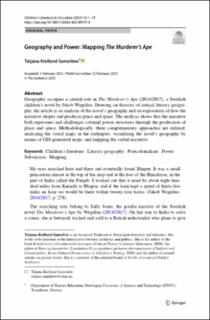| dc.contributor.author | Samoilow, Tatjana Kielland | |
| dc.date.accessioned | 2024-04-11T08:45:10Z | |
| dc.date.available | 2024-04-11T08:45:10Z | |
| dc.date.created | 2022-02-26T12:57:03Z | |
| dc.date.issued | 2022 | |
| dc.identifier.citation | Children's Literature in Education. 2022, 55 1-19. | en_US |
| dc.identifier.issn | 0045-6713 | |
| dc.identifier.uri | https://hdl.handle.net/11250/3126005 | |
| dc.description.abstract | Geography occupies a central role in The Murderer’s Ape (2014/2017), a Swedish children’s novel by Jakob Wegelius. Drawing on theories of critical literary geography, the article is an analysis of the novel’s geography and an exploration of how the narrative shapes and produces place and space. The analysis shows that the narrative both represents and challenges colonial power structures through the production of place and space. Methodologically, three complementary approaches are utilized: analyzing the visual maps in the endpapers, visualizing the novel’s geography by means of GIS-generated maps, and mapping the verbal narrative. | en_US |
| dc.language.iso | eng | en_US |
| dc.publisher | Springer Nature | en_US |
| dc.rights | Navngivelse 4.0 Internasjonal | * |
| dc.rights.uri | http://creativecommons.org/licenses/by/4.0/deed.no | * |
| dc.title | Geography and Power: Mapping the Murderer's Ape | en_US |
| dc.title.alternative | Geography and Power: Mapping the Murderer's Ape | en_US |
| dc.type | Journal article | en_US |
| dc.type | Peer reviewed | en_US |
| dc.description.version | publishedVersion | en_US |
| dc.source.pagenumber | 1-19 | en_US |
| dc.source.volume | 55 | en_US |
| dc.source.journal | Children's Literature in Education | en_US |
| dc.identifier.doi | 10.1007/s10583-022-09479-8 | |
| dc.identifier.cristin | 2005670 | |
| cristin.ispublished | true | |
| cristin.fulltext | original | |
| cristin.qualitycode | 2 | |

